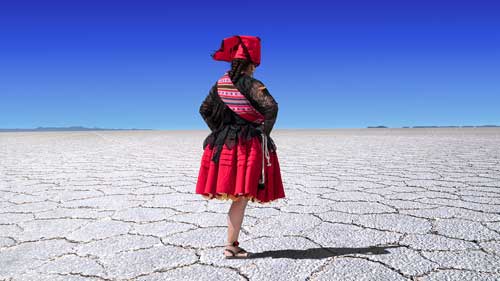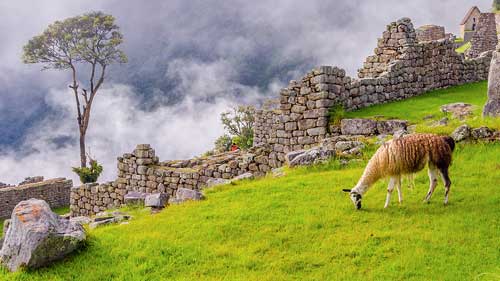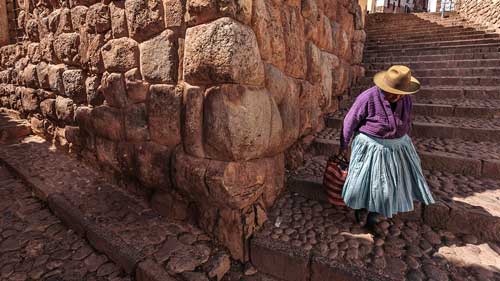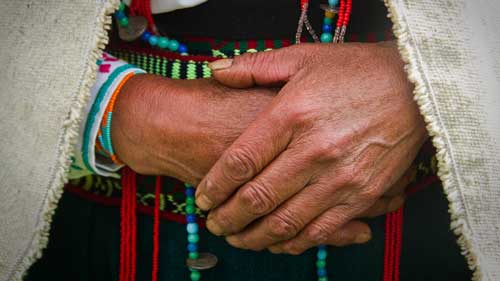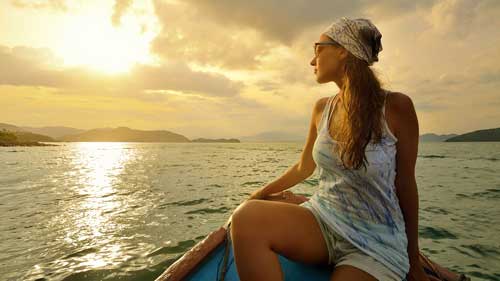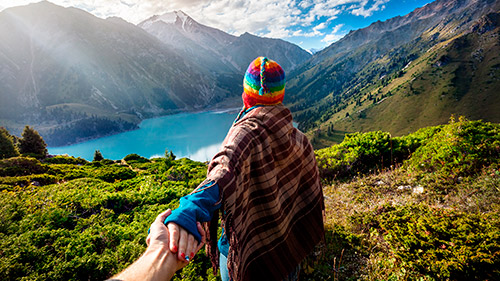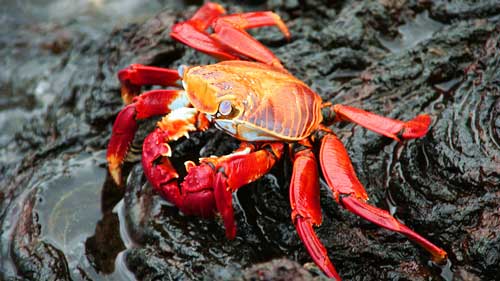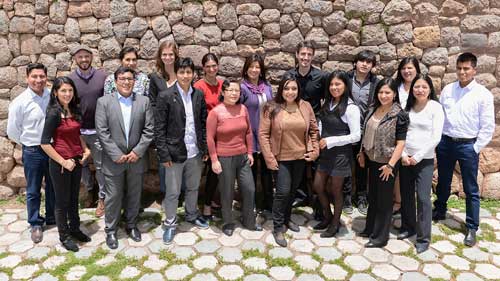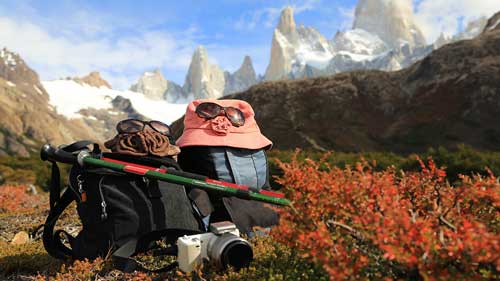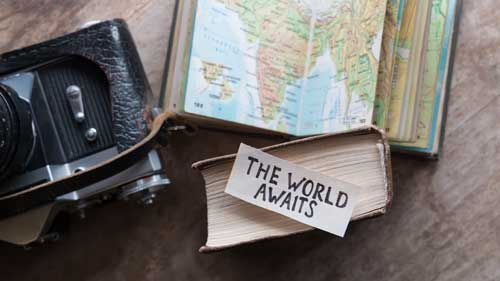What is the Inca Trail?
- The Inca Trail is probably the most famous multi-day hike in Peru. It is known around the world, and is highly controlled and very popular. It is a 4 day hike, starting near Ollantaytambo (km82), climbing up a side valley and then descending to the site of Machu Picchu through the Sun Gate. There are various important ruins sites along the way that you can’t see unless you do the Inca Trail. The only way to do the full Inca Trail is to camp along the way (3 nights). The minimum altitude on the hike is 2,700m.a.s.l. (8,860ft.a.sl.) and maximum altitude 4,200m (13,780ft).There is also the 1 day Inca Trail (see below).
How do Inca trail permits work?
- You can only purchase Inca trail tickets through a licensed agency or guide. Kuoda is not a licensed agency but contracts Apumayo Expeditions (private tours) or Alpaca Expeditions (group tours) for our Inca Trail and trekking services, who are licensed and can be seen on lists of official agencies.
- There are 500 permits available per day, but these count all the people on the trail, including porters (but not guides within the 1:8 ratio).
- You can see the availability for a given month at machupicchu.gob.pe. Click on the ‘Consultas’ tab and choose ‘Camino Inca’ from the drop down menu, as well as the month you are interested in. It is important to note that if you have 4 clients wishing to hike the trail in a private service and there are, say 10 permits left, that is not likely to be enough for the number of porter permits needed. You should check with the operator in these cases.
- Inca Trail permits are directly linked to a specific client name on a particular date and are non-refundable and non-transferable.
- Once Inca Trail permits sell out, there is no way any will become available again.
- Inca trail permits are only available during the calendar year, through January of the following year. The Ministry of Culture releases the permits during the first two weeks of January, so parts of April, May and June can sell out within the first morning of sale.
Do I have to hire a porter?
- Sufficient porters for the camping and cooking equipment are included in the price so you don’t need to worry about carrying general equipment.
- Llama Path offers an ‘additional half porter’, and this is always included with Apumayo; i.e. a porter who will carry around 7kg of guests’ personal items (see luggage restrictions section).
- Porters are permitted to carry up to 25kg, including their own personal items and this is very strictly controlled, so if you don’t pre-book a porter, you will not be able to add one at a later date, or part-way through the trek.
- You might think that 7kg is a very small amount, especially considering the fact that the sleeping bags (and sometimes mats) are included in this weight, but generally it is sufficient, as long as you take only the essentials (see the packing lists).
- You don’t have to hire the additional porter but it is strongly recommended, as the altitude increases the hike’s difficulty, even for experienced hikers; just a few kg of weight makes a huge difference at altitude! Kuoda includes an additional porter as standard.
What alternatives are there to the Inca trail?
The Inca Trail is the only trail that arrives into Machu Picchu, but several others have become popular as alternatives, some arriving to Aguas Calientes by foot/train and others nowhere near! These are the main ones:
SALKANTAY TREK
- 5D4N: 4 days hiking, 3 nights camping, 1 night at a hotel in Aguas Calientes and 1 day at Machu Picchu.
- This starts at around 3,000m and climbs up to 4,500m at the foot of Salkantay mountain, before dropping into the cloud forest, around 2,000m.
- This trek arrives to Aguas Calientes by train from Hidroelectrica (30 minutes). Sometimes it’s possible to walk this last section (9km, 1.5 hours), but it depends on group size, pace and number of guides with the group.
- This route covers the most varied terrain, from highland valleys, to mountain tundra to cloud forest. Some routes visit the ruins of Llactapata (you can see Machu Picchu in the distance from here) on the way, or maybe the hot springs at Cocalmayo.
LARES TREK
- 4D3N; 2.5 days hiking, 2 nights camping, 1 night at a hotel in Aguas Calientes and 1 day at Machu Picchu.
- There are several routes known as the Lares trek:
- Apumayo does Lares – Huacahuasi – Patacancha – Ollantaytmabo (starts at 3,000m, climbs to 4,200m and drops to 2,800m)
- Llama Path does Pumahuanca – Cuncani – Lares (car to Ollantyatmabo) (starts at 3,000m, climbs to 4,800m and drops to 3,000m)
- This can be seen as a more ’cultural’ trek as it gives guests chances to see how people live in high mountain towns. The mountain scenery is quite stunning.
- All routes catch the train from Ollantaytambo to Aguas Calientes on the 3rd day, so that guests can visit Machu Picchu on the 4th
CHOQUEQUIRAO
- 5D4N, 5 days hiking and 4 nights camping; Machu Picchu NOT included.
- Choquequirao is an impressive archaeological site and involves starting at 3,000m, dropping to 1,600m and climbing to 3,000 on the way there and the opposite on the way back. It’s the same path to and from the site although usually different campsites are used on the out and return legs.
- This trail is less popular than the others and is a good option for people who wish for more ‘off-the-beaten-path’ experiences, especially if they have a deep interest in history.
AUSANGATE
- 5D4N 5 days hiking and 4 nights camping or 6D5N 6 days hiking and 5 nights camping; Machu Picchu NOT included.
- This trek circumnavigates the Ausangate mountain, the highest peak in the region and is probably the trek with the most spectacular scenery in the area (including the so called ‘rainbow mountain’).
- The highest pass is at 5,200m and the majority of the trek takes place above 4,000m.
- This trail is less popular than the others and is a good option for people who wish for more ‘off-the-beaten-path’ experiences, especially if they want a ‘wilderness experience’ and mountain scenery.
Do the Trails ever close?
- The Inca Trail closes during February
- The other trails don’t close, although some agencies don’t operate Lares, Salkantay and Ausangate during January and February.
What is included in the trek cost?
Are there different levels of service offered on the treks?
- GROUP SERVICE
Standard service as described, but shared with other trekkers. 16 people maximum per group.
- PRIVATE SERVICE
Standard service as described, but private for your group.
- LUXURY SERVICE
Bigger tents, air mattresses, gourmet meals and snacks, shower and massage service included (see full description in specified documents).
What is the food like that is served on the treks?
How hard are the treks? Do I need to acclimatize before starting a trek?
If you are an experienced hiker, the distances listed in the trek itineraries will seem short, but this is to compensate for the altitude, which really makes a difference to how hard a trek feels. Many of the treks involve steep climbs and descents which can take their toll on your joints. You will want to have done some preparation and be of at least average fitness to really be able to enjoy any of these treks and attitude is very important! A few days of acclimatization before your trek is important as it will help to reduce the risk of you getting sick during the trek, although a couple of days won’t make much of a difference in terms of how hard you find it.
Can I hike the trails with children?
Yes! It obviously depends on the child and it helps a lot if they have some hiking experience so they have an idea what to expect. Some agencies recommend 8-10 years as the minimum age, but children often enjoy the hiking more and cope with the challenge better than adults! You know your child(ren) best; if they are active and like to hike, they will love any of these options!
Can I do these treks without hiring equipment and a support team?
Technically, yes…if you can find a guide who is willing to do the trek carrying his own equipment and cooking his own food! Kuoda does not arrange treks without equipment and support team.
I don’t like to camp, are there any 1 day hiking options?
Yes. There are lots of day hikes, but the main ones would be:
- Huchuy Q’osqo, approximately 6-8 hours hiking, including lunch
- Ollantaytambo-Cachiccata, approximately 6-7 hours hiking, including lunch
- 1 day Inca Trail (km 104), approximately 6-8 hours hiking, including lunch

